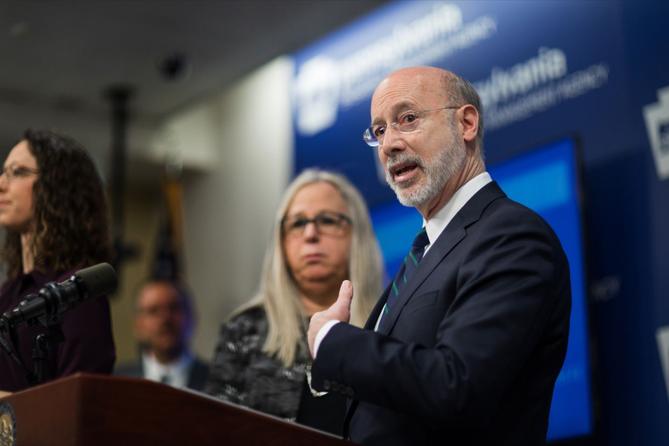Spotlight PA is an independent, nonpartisan newsroom powered by The Philadelphia Inquirer in partnership with the Pittsburgh Post-Gazette and PennLive/Patriot-News. Sign up for our free weekly newsletter.
HARRISBURG — The Wolf administration will begin its reopening experiment next week in large swaths of northern Pennsylvania, the first step in a tiered plan to gradually lift sweeping orders that have shut down nearly every aspect of daily life across the state.
Gov. Tom Wolf on Friday announced that 24 northwest and north-central counties can enter the “yellow” phase of his color-coded reopening plan on May 8th, allowing businesses to resume in-person operations and residents to freely leave their homes if they take precautions.
The counties allowed to do so are Bradford, Cameron, Centre, Clarion, Clearfield, Clinton, Crawford, Elk, Erie, Forest, Jefferson, Lawrence, Lycoming, McKean, Mercer, Montour, Northumberland, Potter, Snyder, Sullivan, Tioga, Union, Venango, and Warren. He did not provide a timeline for reopening other counties.
State officials also broadly outlined how they plan to ramp up testing and contact tracing to the levels needed to safely reopen the state. But the testing goal falls far below what most national experts say is needed, while the contact tracing plan lacked details about how many people the state will hire to do these crucial investigations.
In March, Wolf shuttered much of the state’s economy and began implementing stay-at-home orders to prevent hospitals from being overwhelmed by cases of COVID-19. As GOP lawmakers pressured the governor to lift restrictions on some impacted sectors, Wolf announced he would allow construction to resume statewide and golf courses, campgrounds, and marinas to reopen, as long as precautions are taken on site.
The counties that reopen next week will continue to see some restrictions. Large social gatherings will be banned and many of the activities of daily life, from working to shopping to socializing, will still be curtailed. And should there be an uptick in cases, the governor said he would move swiftly to reinstate strict closure and stay-at-home orders.
But in his mid-afternoon briefing Friday, Wolf tried to strike a positive note, crediting the willingness of residents across the state to stay home for slowing the spread of the virus.
“Over the past two months, Pennsylvanians in every corner of our commonwealth have acted collectively to stop the spread of COVID-19,” the governor said. “Each of these actions seem small individually, but taken together, they built a very powerful weapon against COVID-19."
In the yellow phase, companies must provide teleworking options to employees if their work can be done remotely. If they don’t have that ability, they will be able to reopen with certain safety precautions, which will be announced next week.
Child care operations can resume and retail stores can reopen to customers, though curbside pickup and delivery remains preferable and certain safety precautions must be taken.
Gyms, theaters, indoor recreation centers, hair and nail salons, schools, and casinos will remain closed. Restaurants and bars will only be permitted to remain open for takeout.
The governor stressed that if an outbreak occurs, his administration would quickly move to reinstate his business closure and stay-at-home orders. If there is no spread, the next step would be the “green" phase, where most restrictions are lifted.
“Pennsylvanians living in a county that has been moved to the yellow category should continue to strongly consider the impact of their actions,” Wolf said in a statement.
Wolf said the 24 counties were selected in part because of their low case counts and their ability to conduct testing and contact tracing. They also are largely in less densely populated areas of the state.
The administration said it has partnered with Carnegie Mellon University to create a tool to help it guide its reopening decisions. The model looks at risk factors such as case numbers per capita, population density, hospital bed capacity, and the number of workers employed in a currently closed industry.
Those metrics are then considered along with a county or region’s ability to conduct testing and contact tracing.
Though the administration said it would announce specific metrics for diagnosing and tracing cases, the plans released Friday left unanswered questions.
Testing will still be focused on people with symptoms as well as high-risk populations, health-care workers, and first responders. Under Friday’s plan, the state’s population is broken down into six regions with a goal to test 2% of people in each of those areas monthly.
For the southeastern part of the state, among the hardest hit, the goal translates into 104,670 tests every month. For the entire state, it’s about 256,000.
As of this week, Pennsylvania has averaged about 5,500 tests per day, or about 165,000 per month.
It was not immediately clear how the state intends to increase testing. Health Secretary Rachel Levine said the plan is for hospitals, private health systems and labs, commercial drug stores, and other venues to conduct tests. The goal is for 90% of the state’s residents to live within 45 miles of a testing site.
As for carrying out contact tracing, health officials said they will rely on additional staff, partnerships with local hospital systems, and the use of technology.
But the plan the administration unveiled Friday stopped short of specifying the number of people needed to complete the work, and provided few details on its strategy for the state’s more heavily populated regions. Roughly 60% of the state currently relies on 131 public health nurses to do this work, a number that has dwindled over the years because of budget cuts.
Spotlight PA reporter Aneri Pattani contributed to this story.
100% ESSENTIAL: Spotlight PA relies on funding from foundations and readers like you who are committed to accountability journalism that gets results. If you value this reporting, please give a gift today at spotlightpa.org/donate.
